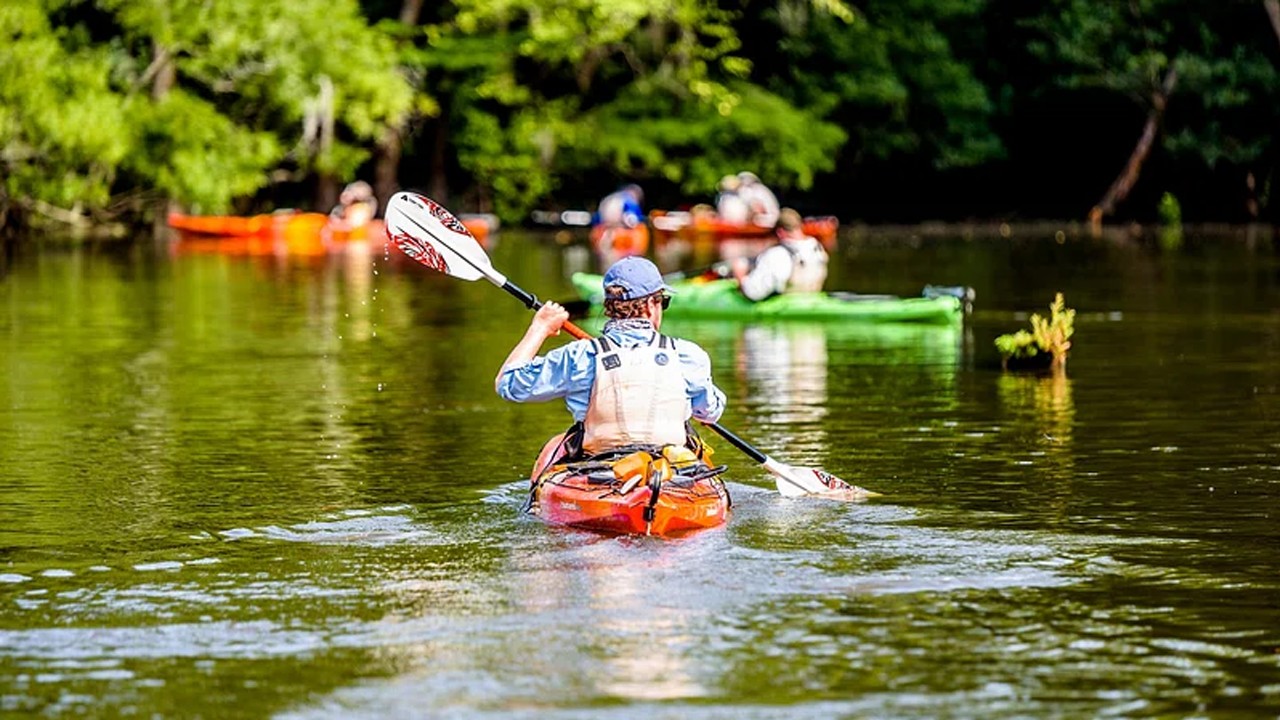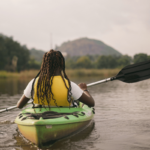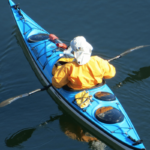Selecting the right canoe paddle is an essential step for any paddling enthusiast, whether you’re embarking on serene lake journeys or navigating challenging river currents. The perfect paddle not only enhances your paddling efficiency but also ensures a more enjoyable and comfortable experience. This guide will walk you through the crucial factors to consider, from length and material to blade shape and grip, helping you find the ideal paddle to match your paddling style and adventures ahead. Dive in to make your next paddle choice your best one yet.
Understanding Paddle Lengths and Sizes
When embarking on the journey of selecting the perfect canoe paddle, understanding the nuances of paddle lengths and sizes becomes paramount. The length of the paddle directly impacts your comfort, efficiency, and overall enjoyment while on the water. It is a common misconception that one size fits all; however, the correct paddle length varies significantly based on several factors including your height, the width of your canoe, and your paddling style.
The first step in determining the appropriate paddle length is to consider your height. Taller paddlers naturally require longer paddles, while shorter paddlers will find shorter paddles more manageable and comfortable. Additionally, the width of your canoe plays a crucial role. A wider canoe necessitates a longer paddle to ensure you can reach the water comfortably without overextending, which could lead to fatigue or discomfort over time. Your paddling style, whether it’s relaxed and leisurely or aggressive and fast-paced, also influences the ideal paddle size. A longer paddle typically suits a more laid-back approach, as it allows for longer, more deliberate strokes, whereas a shorter paddle is better suited for aggressive paddling, providing more control and faster response.
It’s also vital to understand the different parts of the paddle, such as the blade, shaft, and grip, as these components affect the paddle’s overall performance and your comfort. The blade’s shape and size determine the water displacement with each stroke, impacting your canoe’s speed and maneuverability. The shaft’s length and diameter contribute to the paddle’s leverage and how comfortably it fits in your hands. Lastly, the grip affects how effectively you can control the paddle and should feel comfortable in your hands for extended periods.
Here’s a simple table to guide you in choosing the right paddle size based on your height and canoe width:
| Paddler’s Height | Canoe Width | Recommended Paddle Length |
|---|---|---|
| Under 5’5″ | Narrow (under 30 inches) | 50-52 inches |
| 5’6″ – 5’11” | Medium (30-36 inches) | 54-56 inches |
| 6′ and above | Wide (over 36 inches) | 58-60 inches |
| 5’6″ – 5’11” | Wide (over 36 inches) | 56-58 inches |
| Under 5’5″ | Medium (30-36 inches) | 52-54 inches |
Remember, these recommendations are starting points. The best way to find your ideal paddle size is to test different lengths and see what feels most comfortable and efficient. Many outdoor stores offer the opportunity to test paddles, or you might consider renting different sizes before making a purchase. Your goal is to find a paddle that feels like a natural extension of your body, one that allows you to enjoy your time on the water fully, whether you’re meandering down a calm river or navigating the challenges of swift currents.
Selecting the Right Paddle Material
Choosing the correct material for your canoe paddle is crucial for both comfort and performance. The material affects the paddle’s weight, durability, and how it feels in your hands and moves through the water. The most common materials are wood, fiberglass, carbon fiber, and aluminum/plastic combinations. Each has its unique benefits and drawbacks. Wood paddles are traditional, offering a warm, natural feel and flex that many paddlers prefer. However, they require more maintenance to protect against water damage.
Fiberglass paddles strike a balance between weight and durability, making them a popular choice for recreational paddlers. They are less expensive than carbon fiber but slightly heavier. Carbon fiber paddles are the lightest and most rigid, providing excellent efficiency with each stroke. They are ideal for long-distance paddling but come at a higher cost. Aluminum and plastic paddles are the most affordable, offering good durability, but they tend to be heavier and less comfortable during prolonged use.
When selecting a paddle material, consider the type of canoeing you plan to do, your budget, and personal preferences in terms of weight and feel. No matter the material, ensure the paddle fits your body size and paddling style for the best experience on the water.
Further Considerations in Paddle Material Selection
Delving deeper into the selection of paddle materials, it’s essential to consider the environmental conditions where you will be paddling. For instance, if you frequently paddle in rocky, shallow waters, a more durable material like aluminum or a high-impact plastic blade might be preferable to prevent damage. Conversely, in smooth, open water, a lighter paddle such as carbon fiber can reduce fatigue and improve speed. Understanding these nuances ensures that your paddle not only fits you but also your paddling environment.
Understanding Paddle Durability and Performance
Performance and durability are key factors influenced by the paddle’s material. A paddle that is too heavy can lead to quicker fatigue, while one that is too light might not provide enough resistance for effective strokes. Similarly, the material’s durability impacts not just the lifespan of your paddle but also its performance over time. Frequent paddlers, especially those navigating challenging conditions, should prioritize durability to avoid the cost and inconvenience of frequent replacements.
- Wood: Traditional, requires maintenance
- Fiberglass: Balance of weight and durability
- Carbon Fiber: Lightweight and efficient
- Aluminum/Plastic: Affordable, durable
- Considerations: Type of canoeing, budget, personal preference
Blade Shape and Paddle Efficiency
The shape of the canoe paddle’s blade plays a crucial role in its efficiency in the water. A well-chosen blade shape can significantly enhance your paddling experience, offering a blend of power and maneuverability that suits your paddling style and the conditions you expect to encounter. Broadly speaking, paddle blades can be classified into wide and narrow shapes, each with its advantages and disadvantages.
Wide blades offer more surface area, making them ideal for powerful strokes and providing maximum water displacement with each paddle. This design is particularly beneficial for short bursts of speed and for paddlers needing extra control in rough waters. However, the larger surface area can also lead to increased resistance, making the paddle more challenging to handle, especially over long distances.
Narrow blades, on the other hand, are designed for efficiency over long distances. They slice through the water more easily, reducing paddler fatigue and allowing for a higher stroke rate. This shape is preferred by those engaging in long expeditions or when speed and endurance are paramount. The compromise here is a reduction in immediate power, which might not be suitable for all conditions.
Understanding the balance between blade shape and paddle efficiency is vital for selecting the right paddle for your canoeing adventures. Consider your physical strength, paddling style, and the types of water bodies you plan to navigate when making your choice.
| Blade Shape | Advantages | Disadvantages |
|---|---|---|
| Wide | Powerful strokes, Ideal for control in rough water | Increased resistance, Can be tiring over long distances |
| Narrow | Efficient for long distances, Less fatiguing | Less immediate power, Not ideal for rough conditions |
| Asymmetrical | Balanced for power and efficiency, Versatile | Requires skill to maximize benefits |
| Diagonal | Good for specialized strokes, Unique maneuverability | Not suitable for general use, Learning curve |
Additional insights into the relationship between blade shape and paddle efficiency reveal a spectrum of options designed to meet various paddling needs. Whether you prioritize speed, power, or ease of use, understanding these nuances allows for a more informed decision. This knowledge ensures that you select a paddle that not only complements your canoeing style but also enhances your experience on the water, making every stroke count.
Paddle Grip and Comfort Considerations
Choosing the right canoe paddle is crucial for a comfortable and efficient paddling experience. The grip of the paddle plays a significant role in this, as it is the primary point of contact between the paddler and the paddle. A well-designed grip can reduce fatigue, prevent blisters, and improve control over the canoe. Ergonomically shaped grips that fit naturally in the hand are highly recommended. They should allow for a relaxed grip, minimizing strain on the fingers, wrists, and forearms.
Material is another vital factor in the comfort and performance of a canoe paddle. Wooden paddles are popular for their classic feel and natural warmth, which can be more comfortable in cooler temperatures. However, synthetic materials like fiberglass or carbon fiber offer advantages in weight and durability, albeit often at a higher price point. The choice between materials often comes down to personal preference, the type of canoeing being done, and budget considerations.
The length and width of the paddle also influence comfort and efficiency. A paddle that is too long or too short can lead to awkward paddling positions, which can quickly become uncomfortable. Similarly, the blade’s width can affect the amount of power a paddler can generate and how much effort is required to move the canoe. A balance between length and width, tailored to the paddler’s size and paddling style, is essential for optimal comfort and performance.
Understanding Paddle Ergonomics
Delving deeper into the ergonomics of canoe paddles, it becomes apparent that the shape of the paddle shaft and blade can significantly impact a paddler’s comfort and endurance. A shaft with a slight oval shape can provide a more secure grip, reducing the chance of the paddle twisting in wet conditions. Meanwhile, the blade’s shape should facilitate smooth entry and exit from the water, enhancing the overall paddling rhythm and reducing strain.
| Feature | Benefit | Consideration |
|---|---|---|
| Ergonomic Grip | Reduces hand fatigue | Fit to hand size |
| Material | Balance between weight and durability | Personal preference and budget |
| Length | Efficiency in paddling | Paddler’s height and canoe width |
| Blade Width | Power generation | Paddling style and water conditions |
| Shaft Shape | Improved control and comfort | Oval or rounded for grip |
Further Insights into Paddle Ergonomics
Exploring the nuances of paddle design reveals the subtleties in achieving a balance between power and comfort. The distribution of weight along the paddle, the flexibility of the shaft, and the surface area of the blade are all factors that can influence a paddler’s experience. These elements should be harmonized to suit individual needs, highlighting the importance of testing different paddles to find the perfect match for one’s paddling style and physical characteristics.
Matching Paddle to Canoeing Style
Choosing the right canoe paddle is paramount to achieving an efficient and enjoyable paddling experience. The paddle you select should complement your canoeing style, whether it be touring, racing, or white-water paddling. Each style demands different paddle characteristics for optimal performance and comfort.
For touring, a paddle with a longer, slender blade will offer greater efficiency over long distances, allowing for a smoother and more relaxed stroke. Racing paddlers, on the other hand, might prefer a shorter paddle with a broader blade, designed to maximize power and acceleration with each stroke. White-water enthusiasts require durable paddles that can withstand the rigorous conditions encountered in rapids; typically, these have a strong, robust build and a moderate blade size to offer both power and maneuverability.
Another aspect to consider is the paddle’s material. Wooden paddles are traditional, offering a classic feel and flexibility, but may require more maintenance. Composite materials, such as carbon fiber or fiberglass, are lighter and provide more power with less effort, but they can be more expensive. The choice between materials often comes down to personal preference and the specific demands of your canoeing activities.
- Evaluate your primary canoeing activity (touring, racing, white-water).
- Consider the blade size and shape suited to your activity.
- Choose a paddle length that matches your height and canoe width.
- Decide between a straight or bent shaft based on your paddling style.
- Factor in the paddle’s weight and material for long-term comfort and durability.
In summary, matching your paddle to your canoeing style is crucial for enhancing your paddling efficiency and overall enjoyment on the water. By considering the type of canoeing you’ll be doing, the paddle’s blade size, shape, material, and length, you can select a paddle that feels like a natural extension of your body. This alignment between paddle and paddler facilitates a more harmonious interaction with the water, enabling smoother, faster, and less fatiguing strokes.
Remember, the ideal paddle is one that feels comfortable throughout your journey, aligns with your canoeing activities, and meets your performance expectations. Investing time in choosing the right paddle will pay dividends in your canoeing adventures, making each stroke a testament to the synergy between you, your paddle, and the water.
I’m Adam Reynolds, a dedicated sports writer with a passion for both competitive gaming and betting. In my mid-thirties, I dive deep into the world of sports, providing insightful analyses and strategies to help readers make informed betting decisions. My experience spans various sporting events, where I blend my love for the game with a keen eye for betting trends. Whether I’m dissecting game tactics or offering betting tips, I aim to deliver content that is both engaging and practical. Join me as we explore the exciting intersection of sports and betting together.





